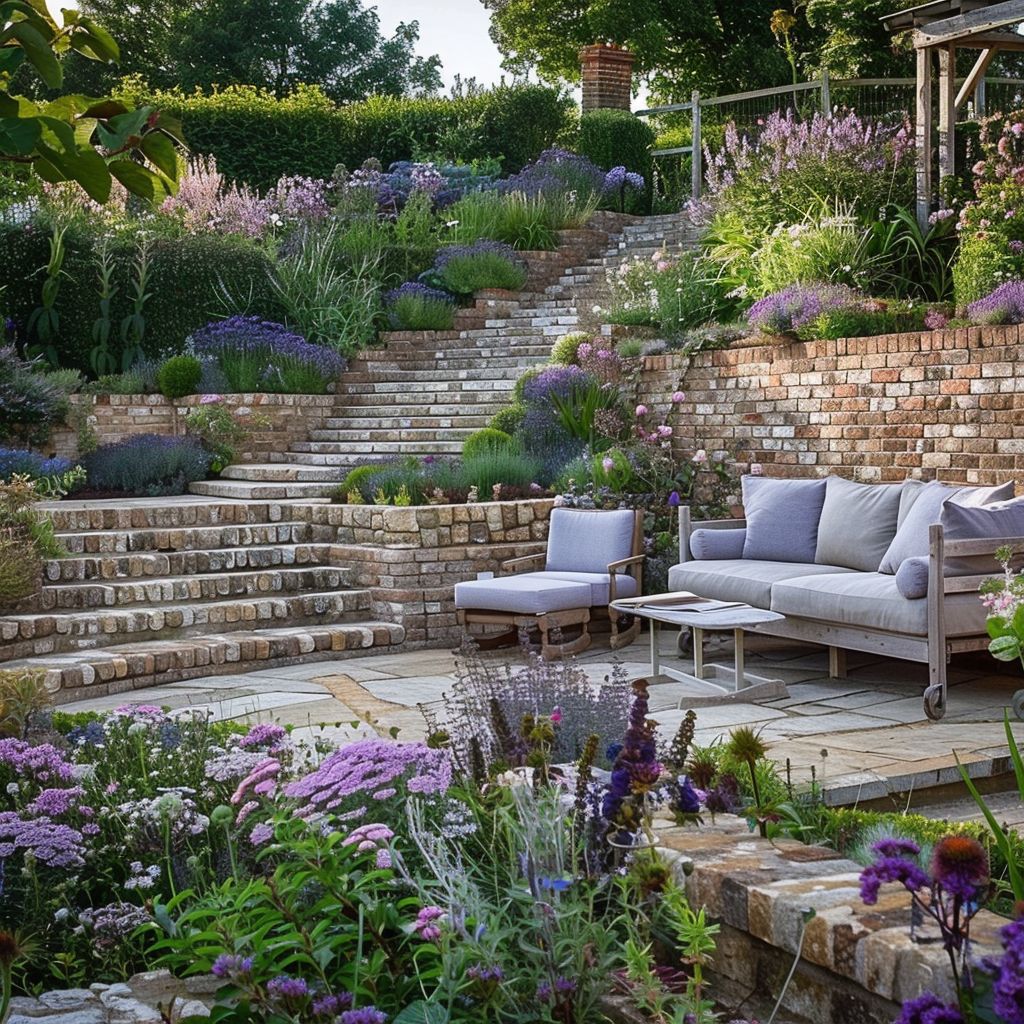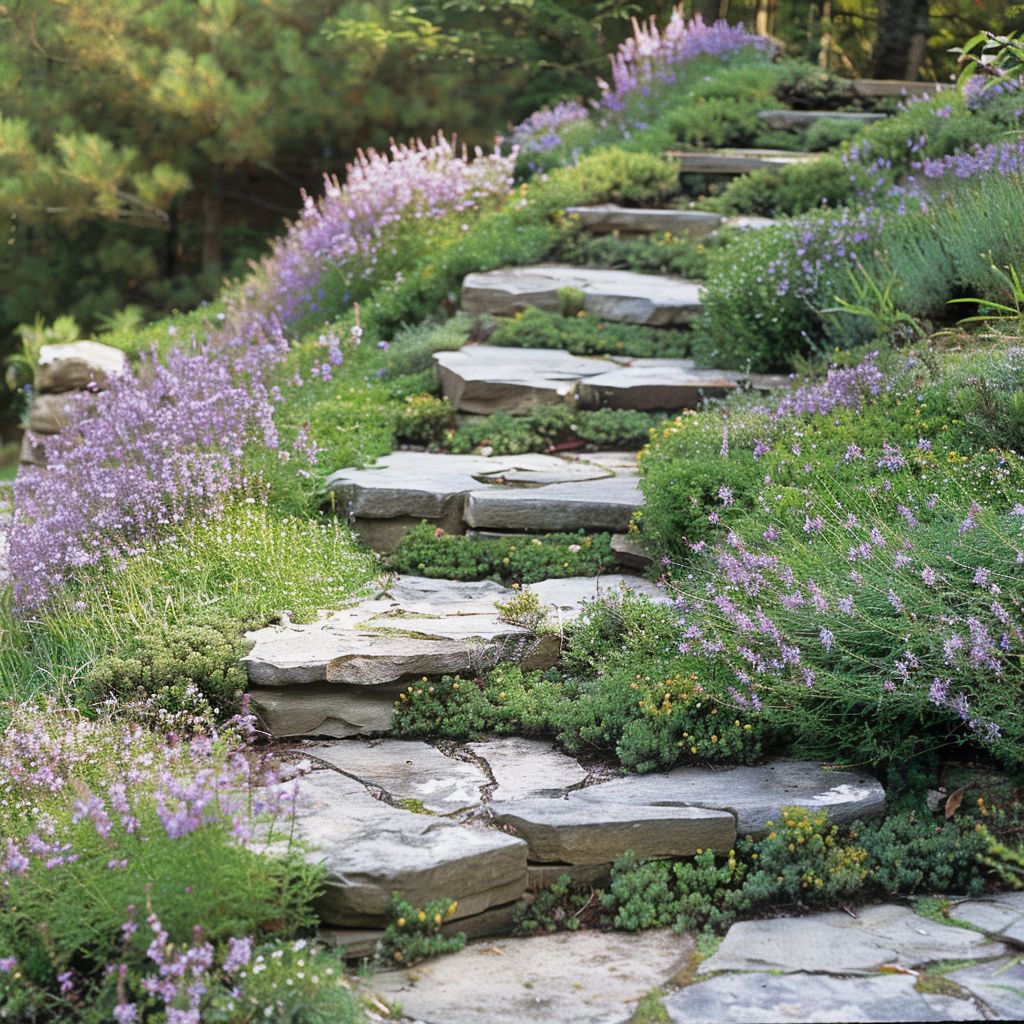Creating your dream garden on a steep slope may well seem daunting at first, but it doesn’t have to be. While sloping sites come with unique challenges like drainage and accessibility, they also offer unparalleled opportunities for creativity and design. Imagine transforming your inclined space into a cascading flower garden or incorporating elegant sandstone steps that guide you through different levels of lush greenery.
With thoughtful planning and clever landscaping, even the steepest slopes can become visually stunning and practical. Don’t let the incline limit your imagination; instead, use it to create an outdoor oasis that’s both unique and functional.
In this article, we’ll explore some inspiring landscaping ideas to help you make the most of your sloped garden, turning potential obstacles into beautiful features.
Essential Consideration for Sloped Gardens
Transforming a sloped garden into a beautiful space requires careful planning and execution. Here are key considerations to help you make the most of your inclined outdoor area.
Evaluating Soil Quality and Stability
Assess your soil’s structure, texture, and pH levels. This helps you determine the best plants for your garden. Poor-quality soil can be ideal for wildflowers or meadow flowers that need minimal upkeep. Terracing is another strategy to create manageable and visually appealing sections.
Incorporating Efficient Drainage Solutions

Proper drainage is crucial to prevent waterlogging and erosion on slopes. Materials like compacted type 1, geotextile fabric, and land drains can help manage water flow effectively. Mulching with composted bark allows water to soak into the soil instead of running off.
Choosing Appropriate Plant Types
Selecting the right plants is essential for a sloped garden. Evergreen shrubs provide year-round interest and stabilise the soil with their extensive root systems. Self-sowing perennials like corydalis can fill gaps naturally, adding charm without much effort.
By considering these factors, you’ll be better equipped to tackle the challenges of designing a stunning sloped garden that stands out in any landscape.
Innovative Landscaping Techniques for Slopes
Transforming sloped gardens into beautiful, functional spaces is entirely possible with creative landscaping techniques. Here are a few ideas to get you started.
Building Retaining Walls for Better Soil Management
Construct retaining walls to manage soil erosion and create distinct areas in your garden. Use materials like stone or timber for a natural look that complements the landscape. These walls not only stabilise the slope but also provide opportunities for planting beds or seating areas.
Creating Terraced Layers to Enhance Accessibility

Create terraced layers on your slope to improve accessibility and usability. Each level can serve a different purpose, such as planting zones or outdoor living spaces. This approach maximises space while making it easier to move around the garden.
Utilising Stairways and Pathways for Easier Navigation
Build stairways and pathways to navigate slopes more conveniently. Materials like flagstone or gravel add texture and interest while ensuring safety. Well-placed steps can lead visitors through various garden sections, turning the incline into an engaging journey.
By incorporating these techniques, you’ll turn even the steepest slopes into enjoyable, practical garden spaces.
Design Elements to Transform Sloped Gardens
Transforming a sloped garden into a functional and beautiful space can be an exciting challenge. Here are some key design elements to consider.
Introducing Steps and Tiers for Aesthetic Appeal
Steps and raised flower beds add structure. They create distinct zones within the garden, making it visually engaging. Terracing is great for steep slopes. It involves building retaining walls to make flat spaces, which can serve different purposes. Lighting on steps enhances safety and creates a charming atmosphere at night.
Adding Functional and Decorative Water Features

Water features like streams or dry creek beds control erosion while adding beauty. Cascading water down slopes can manage moisture levels effectively. Creating a dry creek bed works well if you lack a natural water source, providing an attractive focal point without needing constant flow.
Establishing Zoned Areas for Diverse Garden Activities

Creating separate areas in your garden allows for various activities. Nestle outdoor living spaces into hillside flower beds for relaxation spots with stunning views. Use steps leading to raised patios or pergolas to provide privacy and unique viewpoints of your garden’s beauty.
By incorporating these elements, you can turn any sloped garden into a visually appealing and practical haven.
Plant Selection for Sloped Gardens
Choosing the right plants for your sloped garden can make all the difference. It’s essential to consider light, soil conditions, and plant types that thrive on slopes.
Optimising Plant Choices Based on Light and Soil Conditions
Select plants suited to the amount of sun or shade your slope receives. For sunny areas, opt for lavender or sedum. In shady spots, try ferns or hostas. Pay attention to soil type as well. Sandy soils drain quickly but can be dry, whereas plants for arid soils thrive in these conditions. Clay soils hold water but may need better drainage.
Integrating Native Plants for Sustainability

Using native plants is a smart move. They’re adapted to local climate and soil, requiring less maintenance. Kangaroo paw and grevillea are excellent choices in Australia. These plants are great at handling local weather patterns and pests.
Employing Ground Covers to Prevent Erosion

Ground covers are lifesavers on slopes. They spread quickly and anchor loose soil with their roots. Consider planting creeping thyme or prostrate rosemary. Their dense mats will help prevent erosion while adding beauty to your garden.
By focusing on these aspects, you’ll create a thriving sloped garden that’s both beautiful and low-maintenance.
Practical Tips for Maintaining a Sloped Garden
Managing a sloped garden can be challenging, but with the right strategies, you can create an attractive and functional space. Here are some practical tips to help you maintain your sloped garden effectively.
Strategies for Long-Term Soil Health
- Mulching: Apply mulch like composted bark to reduce water runoff and erosion.
- Native Plants: Use native plants that resist erosion and require minimal care.
- Groundcovers: Plant groundcovers that spread easily and prevent soil erosion.
Water Management Techniques Specific to Slopes
- Informal Mini-Terracing: Dig holes deeper at the back to slow water flow.
- Terracing: Create flat beds using logs or rocks to stop soil movement.
- Drainage Systems: Install good drainage behind retaining walls to avoid cracks.
- Plant Selection: Choose shrubs and trees with strong root systems for stability.
- Pruning: Trim plants regularly to control growth and enhance appearance.
- Weeding: Remove weeds promptly to minimise competition for nutrients.
By following these tips, you’ll keep your sloped garden healthy, beautiful, and easy to manage all year round.
Up next:
